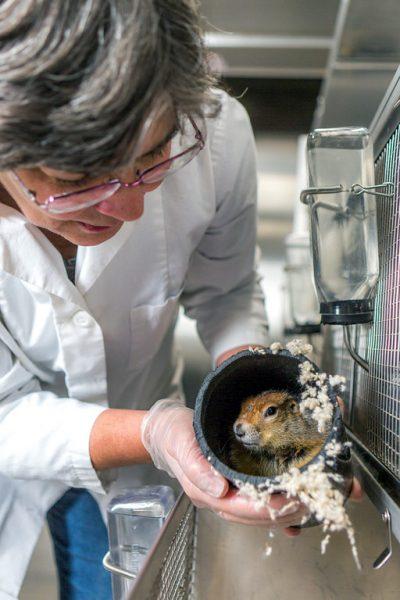
Credit: UAF photo by Todd Paris
A new five-year, $11.8 million National Institutes of Health grant will help University of Alaska scientists translate their knowledge of hibernating animals into treatments that advance human health.
The University of Alaska Fairbanks Institute of Arctic Biology will lead the newly formed Center of Transformative Research in Metabolism. University of Alaska Anchorage researchers will also participate.
Hibernating animals, such as arctic ground squirrels and black bears, undergo unique changes in their metabolism — the processes that build and break down materials in living cells and provide them with energy. These changes allow the animals to survive long periods of reduced activity and body temperature with no health problems.
Understanding these adaptations could reveal ways to treat certain human health problems, such as atrophy in unused and aging muscles, obesity, type 2 diabetes and cardiovascular diseases.
The center will build on the university’s long history of research into northern animals that hibernate through Alaska’s winters.
“We’re going to understand the novel insights that they provide and be able to translate that into human applications,” said UAF professor Kelly Drew, who led the effort to obtain funding.
Knowing more about hibernating animals may point to new treatments for metabolic diseases in humans, according to IAB Director Brian Barnes, a UAF professor who has studied arctic ground squirrels for more than three decades.
“This is a big deal since it shows NIH’s recognition of hibernation as a deserving model for investment in biomedical research and UAF as a national and international center of expertise in hibernation and medical applications,” he said.
At UAF, the money initially will upgrade and maintain magnetic resonance imaging machines in the Murie and Reichardt buildings. It will also renovate part of the Robert G. White Large Animal Research Station on Yankovich Road to create a breeding colony of arctic ground squirrels.
Professor Trey Coker, who will lead the UAF research, already runs a lab that specializes in the study of problems related to human metabolism, such as obesity and muscle loss in aging adults. Hibernation research will enhance that work, Drew said.
At UAA, the grant will pay for equipment and technicians to advance research into microbial communities. Professor Khrys Duddleston, the UAA project leader, has been studying how gut microbes in arctic ground squirrels might help them maintain muscle mass during eight months in hibernation.
In total, the grant will support about 10 researchers, Drew said.
The UA effort is funded by the NIH’s Institutional Development Award program as a Center of Biomedical Research Excellence. The IDeA program’s COBRE grants support three five-year research phases. They are intended to build facilities and expertise in states that are working to grow their biomedical research infrastructure.
###
Media Contact
Marmian Grimes
[email protected]
Original Source
http://bit.




